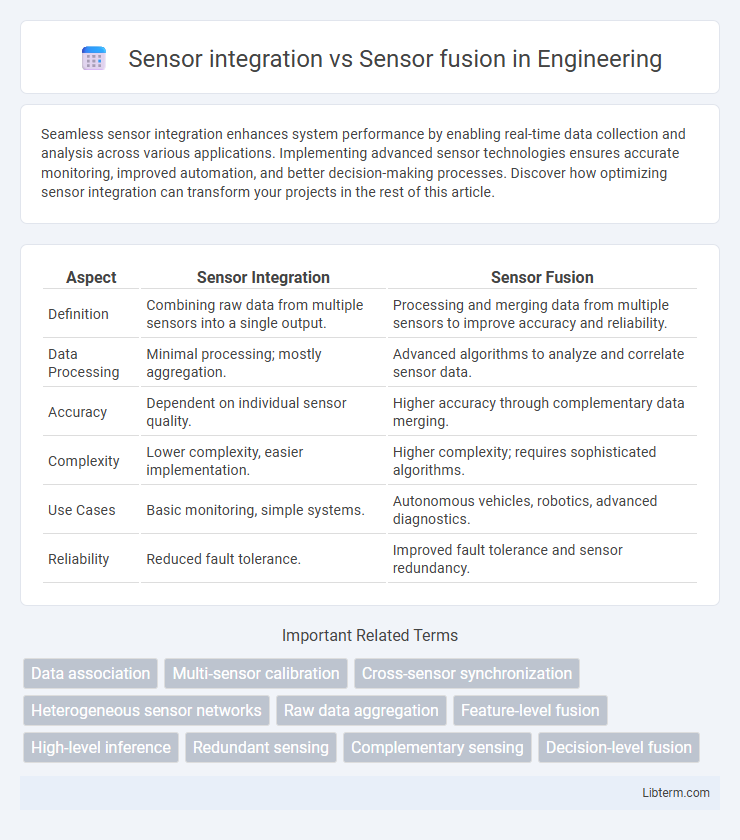Seamless sensor integration enhances system performance by enabling real-time data collection and analysis across various applications. Implementing advanced sensor technologies ensures accurate monitoring, improved automation, and better decision-making processes. Discover how optimizing sensor integration can transform your projects in the rest of this article.
Table of Comparison
| Aspect | Sensor Integration | Sensor Fusion |
|---|---|---|
| Definition | Combining raw data from multiple sensors into a single output. | Processing and merging data from multiple sensors to improve accuracy and reliability. |
| Data Processing | Minimal processing; mostly aggregation. | Advanced algorithms to analyze and correlate sensor data. |
| Accuracy | Dependent on individual sensor quality. | Higher accuracy through complementary data merging. |
| Complexity | Lower complexity, easier implementation. | Higher complexity; requires sophisticated algorithms. |
| Use Cases | Basic monitoring, simple systems. | Autonomous vehicles, robotics, advanced diagnostics. |
| Reliability | Reduced fault tolerance. | Improved fault tolerance and sensor redundancy. |
Introduction to Sensor Integration and Sensor Fusion
Sensor integration refers to the process of combining data from multiple sensors to enhance system accuracy and reliability without necessarily merging the sensor outputs into a unified interpretation. Sensor fusion goes beyond integration by algorithms that synthesize data from diverse sensors to create a comprehensive and coherent understanding of the environment. In applications like autonomous vehicles and robotics, sensor fusion significantly improves decision-making by reducing uncertainty and compensating for individual sensor limitations.
Definition of Sensor Integration
Sensor integration refers to the process of combining raw data from multiple sensors into a single system to enhance functionality or improve data acquisition accuracy. It involves physically and electronically connecting sensors to a central processing unit without necessarily merging the data at an interpretive level. This approach enables simultaneous data collection from various sources but does not inherently perform complex data analysis or synthesis like sensor fusion.
Definition of Sensor Fusion
Sensor fusion is the process of combining data from multiple sensors to produce more accurate, reliable, and comprehensive information than individual sensors can provide alone. Unlike sensor integration, which simply collects and manages data from various sensors, sensor fusion employs advanced algorithms and models to interpret and merge sensor inputs cohesively. This technique enhances decision-making in applications such as autonomous vehicles, robotics, and environmental monitoring by reducing uncertainty and improving situational awareness.
Key Differences between Sensor Integration and Sensor Fusion
Sensor integration combines data from multiple sensors by simply aggregating raw inputs without significant processing, while sensor fusion merges data at a deeper level using algorithms to generate more accurate, reliable, and comprehensive information. Sensor integration often leads to redundant or conflicting data, whereas sensor fusion resolves ambiguities by correlating and weighting input from diverse sensors. The key difference lies in sensor fusion's ability to enhance situational awareness through intelligent data synthesis, compared to sensor integration's basic data consolidation.
Advantages of Sensor Integration
Sensor integration enhances system reliability by combining raw data from multiple sensors to provide a comprehensive and real-time environmental understanding. It simplifies data processing by aligning sensor outputs into a unified framework, reducing redundancy and improving accuracy in applications such as autonomous vehicles and robotics. This approach also enables scalability and flexibility, allowing for easier incorporation of new sensor technologies without extensive system redesign.
Benefits of Sensor Fusion
Sensor fusion combines data from multiple sensors to provide more accurate, reliable, and comprehensive information than individual sensor integration alone. It enhances system performance by reducing uncertainty, filtering out noise, and improving decision-making capabilities in applications like autonomous vehicles and robotics. The synergy of diverse sensor inputs through sensor fusion enables robust perception and real-time situational awareness.
Common Applications of Sensor Integration
Sensor integration involves combining data from multiple sensors to provide a broader understanding of an environment, commonly used in automotive systems for advanced driver-assistance, industrial automation for process monitoring, and smart home devices for comprehensive environmental control. This approach enhances system reliability and accuracy by leveraging complementary sensor inputs such as cameras, LiDAR, and ultrasonic sensors in robotics and autonomous vehicles. Compared to sensor fusion, integration primarily focuses on collecting and using sensor data separately without complex algorithms to merge the data into a unified interpretation.
Typical Use Cases for Sensor Fusion
Sensor fusion is commonly employed in autonomous vehicles, robotics, and smart devices to combine data from multiple sensors such as LiDAR, radar, cameras, and inertial measurement units (IMUs) to improve accuracy and reliability in object detection, navigation, and environment mapping. Unlike sensor integration, which merely aggregates raw data from various sensors, sensor fusion processes and interprets this data to create a comprehensive understanding of the surrounding environment. Typical use cases include advanced driver-assistance systems (ADAS), drone navigation, and augmented reality applications where precise real-time situational awareness is critical.
Challenges in Sensor Integration and Fusion
Sensor integration faces challenges such as hardware compatibility, signal interference, and data synchronization issues, which can hinder accurate data collection and analysis. Sensor fusion involves complex algorithms to combine heterogeneous data sources, requiring robust data alignment, noise reduction, and real-time processing capabilities. Addressing these challenges is critical for applications in autonomous vehicles, robotics, and IoT systems to ensure reliable and precise environmental perception.
Future Trends in Sensor Technology
Sensor integration combines raw data from multiple sensors into a single platform, enhancing overall system functionality, while sensor fusion processes and interprets this data to generate more accurate and reliable information. Future trends in sensor technology emphasize advanced machine learning algorithms and edge computing for real-time sensor fusion, enabling autonomous systems and smart environments to operate with higher precision. Quantum sensors and bio-integrated sensors are also emerging, promising unprecedented sensitivity and seamless integration for next-generation applications.
Sensor integration Infographic

 libterm.com
libterm.com